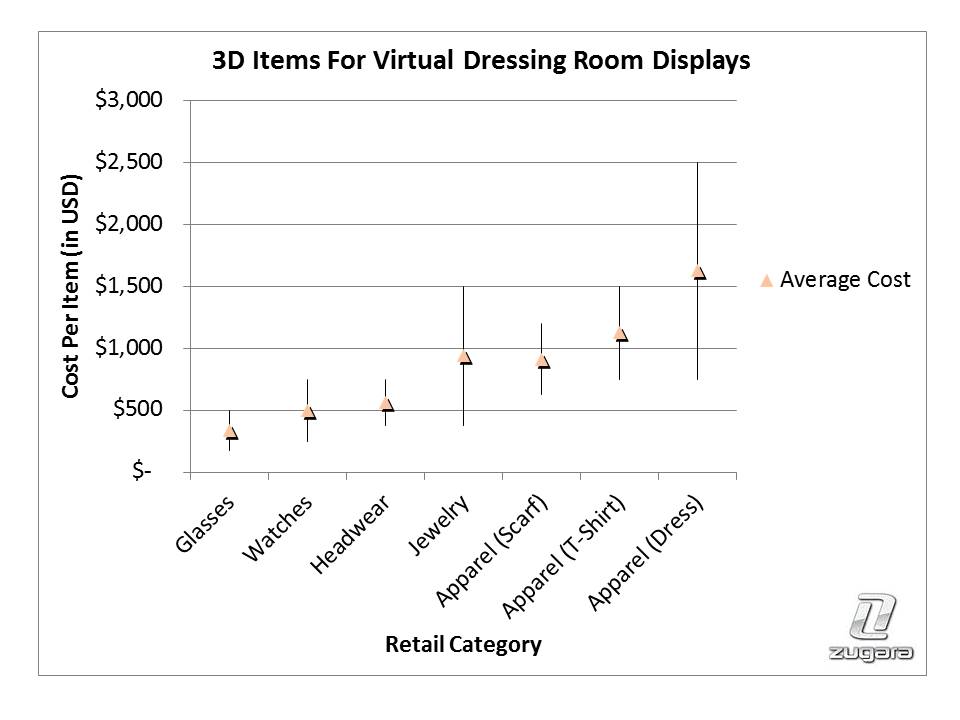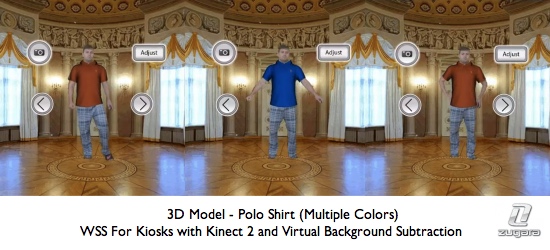“How Much Do Virtual Dressing Room 3D Models Cost?” is a question we get asked about every day. Since we have answered this question in detail more times than we’d like to count, we thought it best to create a graphic and breakdown of the variables that affect the cost of various 3D items for Virtual Dressing Room technology.
Note: We have a new blog post outlining when to use 2D vs. 3D Virtual Dressing Room Technology. This post covers some of the advantages and disadvantages of 3D virtual dressing room technology (with video examples).
In the chart above we have broken down Retail Category items into the most asked about apparel or accessory items for Virtual Dressing Rooms. Keep in mind that these are just rough cost spreads and averages and different variables affect the cost of apparel items and accessories. Also, creating 3D wearable objects for a virtual reality simulation or augmented reality simulation using an avatar are less complex than creating 3D wearable objects that need to track in real time in a live video feed to the motion, position and orientation of the subject. The trade off is that an AR or VR avatar-based solution is often less life-like with predefined movements and body shapes whereas a 3D wearable object that moves with you in real-time and in a live video display appears more life like (as you are viewing yourself with virtual apparel in a mirror.) Here are 4 main factors that affect the cost and complexity in creating a 3D apparel item or accessory:
- Static or Dynamic object. A watch would be considered a static object as it’s rigid and doesn’t require that physics are applied to it when it moves in a virtual dressing room simulation. A dress or apparel item would be considered dynamic as the virtual 3D dress object needs to flow naturally in the display as it tracks to the position, orientation or movement of the user.
- CAD file available. Most products generally have a CAD model created prior to going into production. Everything from autos to glasses to watches generally have a CAD file present. If the CAD file has already been created, it can be utilized with 3D modeling software. However, most retail items like dresses, shirts or scarves do not have CAD files created and are usually based on sketches before production. For 3D, this then requires that the 3D model is created off a sketch or photo which generally means you have to start from scratch.
- Physics complexity. When creating a 3D item or accessory, it will need to look as life-like as possible in the display. This generally means that physics need to be added to the movement of the item in the display. A dress would require more complex physics while a scarf would require less complex physics.
- Tracking complexity. Any 3D virtual dressing room item needs to track to the motion, position and/or orientation of the user in the live video display. Where that tracking occurs dictates how complex the tracking needs to be. Tracking 3D glasses to a users face and subsequent rotation of the users face is much easier than tracking a 3D dress object that needs to track to the entire user’s body’s rotation with the 3D object flowing dynamically.
As for specific Retail category items, we have tried to provide some insight into what is involved with 3D modeling for items in each respective category. At the end of this blog post, we’ll go over other variables that will reduce costs or make 3D modeling more efficient. Here are the different retail categories and examples of complexity for 3D models:
- Glasses. Glasses are the least complex 3D object to create. Most glass frames already have CAD models created that can be imported into 3D authoring software. Glasses are also a static object that require little to no physics application to function in a virtual dressing room display. Glasses are also the easiest to track in 3D as they generally only need to rotate 90 degrees based on the user turning their face left to right.
- Watches. 3D models of watches are similar to glasses as most have CAD models created and can be imported into 3D authoring software. However, watches get a bit more complex based on displaying a virtual watch on a user’s wrist and tracking the virtual object to the rotation of the wrist. Unlike facial features that are easier to track for glasses (eyes, nose, ears), the wrist requires more complex computer vision algorithms for general tracking. As a result, most virtual dressing room simulations with 3D watch models still require the user to wear a band that acts as a marker to position, track and display the 3D watch model.
- Headwear. Headwear 3D modeling is inverse that of Glasses. Most headwear including hats do not have CAD models created so have to be modeled from the ground up. This requires using a photo of the headwear or hat and creating the 3D model and adding a texture. Similar to Glasses, the 3D headwear is generally a static object that tracks to a narrowly defined tracked area – the user’s face and head. The complexity occurs when placing and tracking the 3D headwear item to a user so it looks as natural as possible during rotation.
- Jewelry. Jewelry has multiple items that dictate the broad range of 3D cost creation. An item such as a ring is on the lower scale of 3D model development since it is a static object that is tracking to a specific area (hand and finger). Complexity occurs when the ring needs to be rotated in 3D and tracked to the user’s specific hand and/or finger movement. On the higher end of 3D cost creation are objects like earrings or pendants. 3D earrings can be a static or dynamic object. For 3D earrings that need to hang off the ear, physics would need to be applied to match the 3D object movement to the user’s movement.
- Apparel – Scarves. Most apparel items or accessories do not have CAD models created and require the 3D model to be created from scratch. Though scarves can be static objects, they look better when dynamic with physics applied.
- Apparel – T-Shirts. T-Shirts generally require a 3D model to be created and that the 3D item is dynamic to allow for physics and movement. However, T-shirts generally come in multiple colors so only one model needs to be created and then multiple textures can be applied to create multiple 3D items of the same T-shirt. You can view an example of a 3D T-Shirt model in the above graphic or an example we displayed at the Smithsonian here.
- Apparel – Dresses. Dresses tend to be the most complex 3D model to create. On the low end of costs are single color or basic dress models that need to be created. On the high end are more complex dresses like a full length dress with sequins, multiple garment patterns or different fabric combinations (see through lace material on arms.) These take the most amount of time to create in 3D and then also require that physics are applied to the model to flow naturally in a Virtual Dressing Room display.
As you can see from list above, there are quite a few variables that go into pricing of 3D items for Virtual Dressing Rooms. There are ways to reduce costs and complexity which include:
- Volume. If you are creating multiple items, there are likely shared resources that can be utilized between different 3D models to reduce costs. Also, in general, the more 3D items that are being created will lead to a volume discount on pricing.
- Templates. As mentioned above, if templates are created and only different textures are being applied to the same template, this will greatly reduce 3D development costs. As an example, if you are creating one 3D T-Shirt model that will then have 20 different colorways (textures), most of the 3D development cost would be for the initial template model.
- Outsourcing. This is a tricky proposition as you can reduce 3D model creation by outsourcing development. However, this is where the age old saying comes in to play, “You get what you pay for.” While static objects are more suited for cheaper, outsourced development, more complex items like 3D sequin dress models require more advanced 3D design, modeling and animation expertise. The quality of the 3D model also needs to be considered as saving money by creating a low quality texture on a 3D dress model will make the model look less realistic and more cartoonish in the Virtual Dressing Room display.
We hope this helps answer many of the questions we’ve received regarding pricing of 3D models of apparel items and accessories. Given the costs involved with 3D modeling, most of our clients opt for the 2D format which still gives users a general approximation of sizing and how an item might look on them. At this stage, 3D models will not help solve fit or provide tactile feedback on an item for a user which we’ve covered in a previous blog post. However, as both Augmented Reality and Virtual Reality mature and market adoption grows, there will be an increasing need to show 3D elements in these virtual environments (which is covered in more detail on Techcrunch here.) Finally, Augmented Reality Virtual Dressing Rooms can still provide great value to the shopper when the focus is on engagement with the virtual product and using Virtual Dressing Room technology to drive the shopper to a retail store and/or fitting room.
As we progress through 2016, we’ll be releasing details on a new patent pending technology we’re developing that will greatly reduce the costs of 3D model development for Virtual Dressing Room apparel items and accessories. This new technology will open 3D up to a more automated process given that current costs are the result of manually having to create each and every apparel item or accessory in 3D. Please contact us if you have any questions on this blog post or any other Augmented Reality Retail technologies in development at Zugara.
Update 3/14/2018 – We have a new blog post outlining when to use 2D vs. 3D Virtual Dressing Room Technology. This post covers some of the advantages and disadvantages of 3D virtual dressing room technology (with video examples.)
FEB


